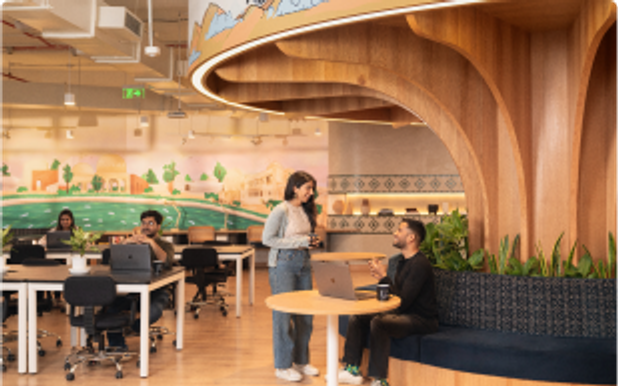NEWS & INSIGHTS
Hybrid work trends in 2024

Explore the latest hybrid work trends in 2024 with WeWork. Learn about benefits of hybrid worksplace, emphasis on cost efficiency of flexi desk in coworking spaces.
The landscape of workplaces has evolved in the last few years, with hybrid work models emerging as a dominant trend. In this blog, we will explore what hybrid work is, the current hybrid work trends in 2024, and answer common questions regarding the implementation and benefits of the hybrid work model.
What is a hybrid work model?
The hybrid work model blends remote work with traditional office-based work, offering employees flexibility in where and when they work. This approach offers the best of both worlds, remote and in-office work environments, accommodating diverse preferences and operational needs of employees within organisations.
Hybrid work trends 2024
In 2024, several key trends are shaping the hybrid work landscape. These include:
Integration of hybrid workspaces
Organisations are increasingly investing in hybrid workspaces that cater to both remote and on-site employees. These spaces are designed to increase collaboration, creativity, and productivity. This trend reflects a strategic shift towards creating adaptable environments that support different work modes.
Emphasis on flexibility and well-being
The focus on employee well-being is increasing, with companies implementing policies that support workplace flexibility and employees’ mental health. Hybrid work helps employees in balancing professional and personal commitments better, leading to improved job satisfaction and their overall well-being.
Use of advance technology
Advancements in technology support the hybrid work model. From virtual communication tools to cloud-based collaboration platforms, organisations are using technology to bridge gaps and ensure seamless connectivity among hybrid teams. This emphasises the importance of investing in digital infrastructure to sustain hybrid and remote work environments effectively.
Rise of coworking spaces
Coworking spaces like WeWork have gained popularity as alternatives to traditional office spaces. These shared workspaces provide flexibility for remote workers, offering amenities and networking opportunities that enhance productivity and creativity. As more organisations continue to embrace the hybrid work model, coworking spaces act as hubs for collaboration and community engagement.
Final word
The shift towards hybrid work models is redefining how businesses operate and changing the overall employee work experience. By embracing flexibility, technology, and employee-centric practices, organisations can increase the productivity of a hybrid workforce effectively.
FAQs
1. What is the hybrid work model strategy?
The hybrid work model strategy involves designing work policies that blend remote and on-site work options. It aims to increase workplace flexibility, productivity, and employee satisfaction by accommodating diverse work preferences and operational requirements.
2. Why is hybrid work better?
Hybrid work offers several advantages, including increased flexibility, improved work-life balance, reduced commuting time, and enhanced employee morale. It allows organisations to retain top talent, tap into a broader talent pool, and adapt more swiftly to changing business needs.
3. What is an example of hybrid work?
An example of hybrid work could be a team where some members work from home three days a week and come into the office for meetings and collaborative sessions twice a week. This arrangement allows team members to benefit from both remote work autonomy and in-person interactions.
Also Read: How workplace satisfaction impact job satisfaction for an employee?
Related Blogs:

NEWS & INSIGHTS
The world of finance saw a drastic shift in its functional trajectory the moment it was hit by the wave of AI. Like all the other fields of commerce,


